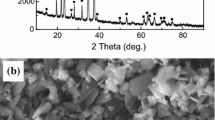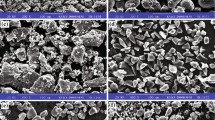Abstract
Melt-SHS (self-propagating high-temperature synthesis), based on the SHS process and oxide reaction method, was used for preparation of TiB2/Al composites. The mass ratio of two reactants, Ti powder/TiO2, in initial powder mixture was varied from 0:1 to 1:0. The results showed that the 5 wt% TiB2/Al composites could be successfully produced by a reaction of aluminum powder, TiO2, and B2O3 in Al melt at 950 °C, while the reaction rate was slow. The addition of titanium powder helps to reduce the content of Al2O3 and destroy the coating structure of Al2O3 covered TiB2 particles, which leads to the acceleration of reaction process and improvement of particle concentration. A significant improvement was that TiB2 particles were dispersively distributed when the mass ratio of Ti powder/TiO2 was 2:3. As a result, the 5 wt% TiB2/Al composites fabricated by melt-SHS process with modified reactants ratio showed excellent tensile properties with the ultimate tensile strength as high as 114.24 MPa. Besides, the composite also showed superior ductility.








Similar content being viewed by others
References
Q. Zhang, W.H. Wu, G.Q. Chen, L.T. Jiang, and B.F. Luan: The thermal expansion and mechanical properties of high reinforcement content SiCp/Al composites fabricated by squeeze casting technology. Composites, Part A 34, 1023–1027 (2003).
C.F. Feng and L. Froyen: Microstructures of in situ Al/TiB2 MMCs prepared by acasting route. J. Mater. Sci. 35, 837–850 (2000).
S. Kumar, V.S. Sarma, and B.S. Murty: A statistical analysis on erosion wear behavior of A356 alloy reinforced with in situ formed TiB2 particles. Mater. Sci. Eng., A 476, 333–340 (2008).
Z.W. Liu, M. Rakita, W. Xu, X.M. Wang, and Q.Y. Han: Ultrasound assisted salts-metal reaction for synthesizing TiB2 particles at low temperature. Chem. Eng. J. 263, 317–324 (2015).
Q. Gao, S.S. Wu, S.L. Lü, X.C.H. Duan, and P. An: Preparation of in situ 5 vol% TiB2 particulate reinforced Al–4.5Cu alloy matrix composites assisted by improved mechanical stirring process. Mater. Des. 94, 79–86 (2016).
S.C. Tjong and Z.Y. Ma: Microstructural and mechanical characteristics of in situ metal matrix composites. Mater. Sci. Eng., R 29, 49–113 (2000).
C.F. Feng and L. Froyen: On the reaction kinetics of an Al–TiO2–B system for producing in situ Al/(Al2O3 + TiB2) composites. J. Mater. Sci. Lett. 19, 103–105 (2000).
R. Koc and D.B. Hodge: Production of TiB2 from a precursor containing carbon coated TiO2 and B4C. J. Mater. Sci. Lett. 19, 667–669 (2000).
P.J. Li, E.G. Kandalova, V.I. Nikitin, A.R. Luts, A.G. Makarenko, and Y.F. Zhang: Effect of fluxes on structure formation of SHS Al–Ti–B grain refiner. Mater. Lett. 57, 3694–3698 (2003).
V.I. Nikitin, W.Q. Jie, E.G. Kandalova, A.G. Makurenko, and L. Yong: Preparation of Al–Ti–B grain refiner by SHS technology. Scr. Mater. 42, 561–566 (2000).
Y.F. Yang and Q.C. Jiang: Effect of TiB2/TiC ratio on the microstructure and mechanical properties of high volume fractions of TiB2/TiC reinforced Fe matrix composite. Int. J. Refract. Met. Hard Mater. 38, 137–139 (2003).
E.M. Sharifi, F. Karimzadeh, and M.H. Enayati: Synthesis of titanium diboride reinforced alumina matrix nanocomposite by mechanochemical reaction of Al–TiO2–B2O3. J. Alloys Compd. 502, 508–512 (2010).
C.L. Yeh and S.H. Su: In situ formation of TiAl–TiB2 composite by SHS. J. Alloys Compd. 407, 150–156 (2006).
A. Changizi, A. Kalkanli, and N. Sevinc: Production of in situ aluminum–titanium diboride composite formed by slag–metal reaction. J. Alloys Compd. 509, 237–240 (2011).
H.L. Zhang, Y.F. Han, J. Wang, Y.B. Dai, and B.D. Sun: An ab initio molecular dynamics study on the structural and electronic properties of AlB2, TiB2 and (Alx, Ti(1−x))B2 in Al–Ti–B master alloys. J. Alloys Compd. 585, 529–534 (2014).
X.Z. Li, X.F. Bian, X.J. Li, and X.F. Liu: Ab initio studies of TiB2 and AlB2 in the Al–Ti–B alloy. Acta Metall. Sin. 37, 235–238 (2001).
S. Lakshmi, L. Lu, and M. Gupta: In situ preparation of TiB2 reinforced Al based composites. J. Mater. Process. Technol. 73, 160–166 (1998).
B.S. Murty, S.A. Kori, K. Venkateswarlu, R.R. Bhat, and M. Chakraborty: Manufacture of Al–Ti–B master alloys by the reaction of complex halide salts with molten aluminum. J. Mater. Process. Technol. 80, 152–158 (1999).
F. Chen, Z.N. Chen, F. Mao, T.M. Wang, and Z.Q. Gao: TiB2 reinforced aluminum based in situ composites fabricated by stir casting. Mater. Sci. Eng., A 625, 357–368 (2015).
Author information
Authors and Affiliations
Corresponding author
Rights and permissions
About this article
Cite this article
Li, H., Chai, L., Wang, H. et al. Fabrication of TiB2/Al composite by melt-SHS process with different content of titanium powder. Journal of Materials Research 32, 2352–2360 (2017). https://doi.org/10.1557/jmr.2017.184
Received:
Accepted:
Published:
Issue Date:
DOI: https://doi.org/10.1557/jmr.2017.184




